
Janatha Vimukthi Peramuna is a Marxist–Leninist communist party and a former militant organization in Sri Lanka. The movement was involved in two armed uprisings against the government of Sri Lanka: once in 1971 (SLFP), and another in 1987–89 (UNP). The motive for both uprisings was to establish a socialist state.
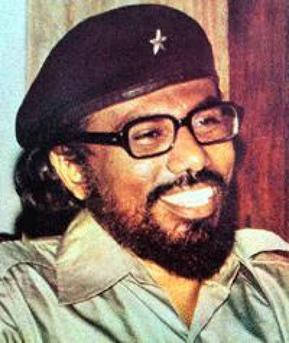
Patabendi Don Jinadasa Nandasiri Wijeweera (Sinhala: පටබැඳි දොන් ජිනදාස නන්දසිරි විජෙවීර; 14 July 1943 – 13 November 1989, better known by his nom de guerreRohana Wijeweera, was a Sri Lankan Marxist-Leninist political activist, revolutionary and the founder of the Janatha Vimukthi Peramuna. Wijeweera led the party in two unsuccessful insurrections in Sri Lanka, in 1971 and 1987 to 1989.
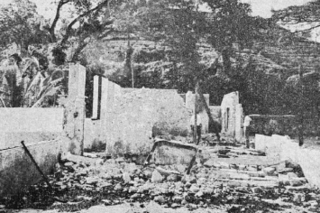
The 1971 Janatha Vimukthi Peramuna (JVP) insurrection was the first of two unsuccessful armed revolts conducted by the communist Janatha Vimukthi Peramuna (JVP) against the socialist United Front Government of Sri Lanka under Prime Minister Sirimavo Bandaranaike. The revolt began on 5 April 1971, and lasted until June of that year. The insurgents held towns and rural areas for several weeks, until the regions were recaptured by the armed forces, following strong support from friendly nations that sent men and material. Although this first attempt to seize power was quickly crushed by force, in 1987 the JVP launched a low intensity insurgency in the island's southern, central and western regions that lasted several years.

The 1987–1989 JVP insurrection, also known as the 1988–1989 revolt or the JVP troubles, was an armed revolt in Sri Lanka, led by the Marxist–Leninist Janatha Vimukthi Peramuna, against the Government of Sri Lanka. The 1987–1989 insurrection, like the 1971 JVP insurrection, was unsuccessful. The main phase of the insurrection was a low-intensity conflict that lasted from April 1987 to December 1989. The insurgents led by the JVP resorted to subversion, assassinations, raids, and attacks on military and civilian targets while the Sri Lankan government reacted through counter-insurgency operations to suppress the revolt.
Nagalingam Shanmugathasan was a trade unionist and Maoist revolutionary leader in Sri Lanka. He was the General Secretary of the Ceylon Communist Party (Maoist)
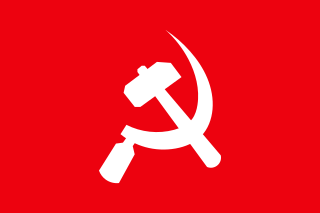
Ceylon Communist Party (Maoist) is a political party in Sri Lanka. The party surged in 1964 following a split in the Ceylon Communist Party. Initially the party just called itself 'Ceylon Communist Party' as well, and was distinguished from the main CCP in Sri Lanka by denominations like 'Ceylon Communist Party ', etc. In the end of the 1960s the party was one of the major leftist parties in the country. Initially Party was led by Premalal Kumarasiri and N. Shanmugathasan.
The Jathika Nidahas Peramuna (JNP) or National Freedom Front (NFF) is a political party in Sri Lanka was formed by the ten JVP parliamentarians led by Wimal Weerawansa, the breakaway group of Janatha Vimukthi Peramuna or JVP, started their political activities on 14 May 2008. The party also achieved a historical milestone for the first time in country's history, a political party launched their official Web site (www.nffsrilanka.com) on the same date the political activities started.
Sellapperumage Saman Piyasiri Fernando, was the military wing leader of the Janatha Vimukthi Peramuna during the 1987-89 insurrection in Sri Lanka, the JVP's military wing also known as Deshapremi Janatha Viyaparaya (DJV). His position in the JVP as the military commander was organizationally higher than the position of Rohana Wijeweera, the founder of the JVP.
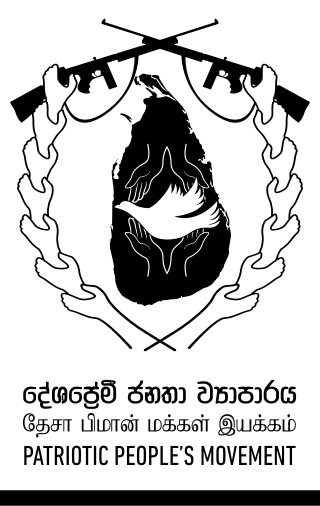
Deshapremi Janatha Vyaparaya was a militant organisation in Sri Lanka. It was widely considered to be the military branch of the Marxist–Leninist Janatha Vimukthi Peramuna and had been designated as a terrorist organisation by the Sri Lankan government.
Dissanayake Mudiyanselage Nandasena (1954–1989), popularly as D. M. Ananda, was a senior leader and a politburo member of the Jantha Vimukthi Peramuna (JVP) during the notorious 1987-89 insurrection. He was the third unofficial leader of the JVP's second insurgency after Wijeweera and Gamanayake. Ananda was captured by Sri Lankan government forces in 1989 and apparently died in captivity.

Don Upatissa Gamanayake, also known by his alias Dias Mudalali, was a Sri Lankan politician and the deputy leader of the Jantha Vimukthi Peramuna (JVP) during the 1987–89 insurrection. Not a prominent figure during the JVP's 1971 insurrection, Gamanayake emerged as a leader only after the releasing of the JVP detainees in 1977. He moved up rapidly in the party hierarchy during the JVP's 1977-83 democratic phase and became the second in command after the founder and the leader, Rohana Wijeweera. He unsuccessfully contested the 1983 Anamaduwa by-election under JVP. Gamanayake was captured and killed by the government forces in November 1989.
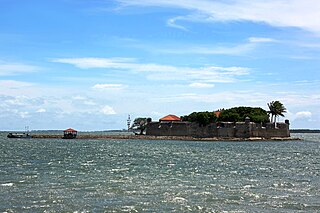
Fort Hammenhiel is a fort built around a small island between the islands of Kayts and Karaitivu of Jaffna Peninsula in Northern Sri Lanka.
Amarasinghe Kankanamlage Somawansa, commonly as Somawansha Amarasinghe, was a Sri Lankan politician, and the 4th leader of Janatha Vimukthi Peramuna, after Rohana Wijeweera, Saman Piyasiri Fernando and Lalith Wijerathna and served as its leader for 23 years until February 2, 2014. He is often described as a strategic leader who socialized the ideological struggle of the JVP into socialism through the nationalist struggle to save the country from Tamil separatist terrorism.
Terrorism in Sri Lanka has been a highly destructive phenomenon during the periods of the Sri Lankan Civil War (1983–2009) and the first and second JVP insurrections. A common definition of terrorism is the systematic use or threatened use of violence to intimidate a population or government for political, religious, or ideological goals. Sri Lanka is a country that has experienced some of the worst known acts of modern terrorism, such as suicide bombings, massacres of civilians and assassination of political and social leaders, that posed a significant threat to the society, economy and development of the country. The Prevention of Terrorism Act of 1978 is the legislation, that provides the powers to law enforcement officers to deal with issues related to terrorism in Sri Lanka. It was first enacted as a temporary law in 1979 under the presidency of J. R. Jayewardene, and later made permanent in 1982.
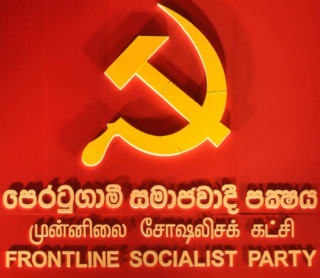
The Frontline Socialist Party is a communist party in Sri Lanka. It was launched on 9 April 2012 by dissident members of the Janatha Vimukthi Peramuna.
Operation Combine was a special operation established by the Sri Lanka Army from 4 August 1989 to February 1990 as counterinsurgency operation with support of the Sri Lanka Police against the Janatha Vimukthi Peramuna (JVP) which had launched a its second insurgency in 1987.
Wijayamuni Devage Athula Nimalasiri Jayasinghe was a Sri Lankan revolutionary and politician. A JVP leader of the 1971 JVP insurrection, Jayasinghe was later elected to the Sri Lankan Parliament and served as a Deputy Minister of Power and Energy.
Communism in Sri Lanka dates back to 1935, when the Lanka Sama Samaja Party was founded by Trotskyists who campaigned for freedom and independence of Sri Lanka which was then a colony of the British Empire and known as Ceylon.

Vijaya Kumaratunga, the Founder of Sri Lanka Mahajana Party, was assassinated by an assassin of Deshapremi Janatha Viyaparaya on February 16, 1988, while leaving his home at Polhengoda in Colombo. Shot in the head as he reached the gate, Kumaratunga died on same day at 12:22 pm, before taking into the hospital. He was the husband of former president of Sri Lanka, Chandrika Kumaratunga and with his funeral created an extended period of national mourning.
Nandathilaka Amadoru Galappaththi Sinhala: නන්දතිලක ගලප්පත්ති; 2 February 1949 – 10 September 1989), was a Sri Lankan political activist who was killed by army forces. He was the Education Secretary and a member of the JVP party in the period 1970–1989. He was also known as Perera, Liyanage and Ari.









